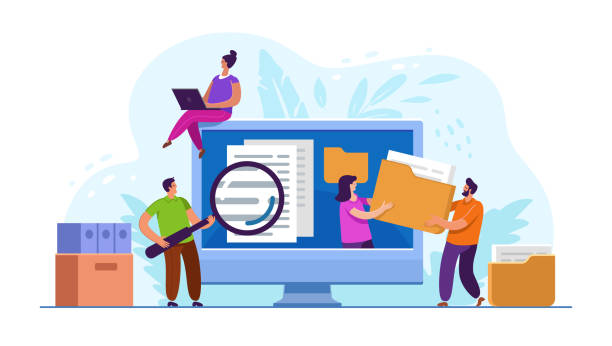The Foundational Importance of Secure Website Design in Today’s Digital World

In the current era, as businesses increasingly move to the web platform, secure website design is no longer a luxury option, but a vital necessity.
With the growing number and complexity of cyberattacks, protecting user information and sensitive company data is a primary concern for every organization.
A vulnerable website can lead to loss of customer trust, data theft, damage to brand reputation, and even heavy legal penalties.
Therefore, the topic of #website_security and #building_a_secure_website must be prioritized at all stages of development, from initial planning to continuous maintenance.
The goal of this guide is to provide a comprehensive and specialized insight into understanding the various aspects of web security and how to implement a penetration-resistant online platform.
We will show you how to build a secure digital infrastructure to protect both your data and your users from potential threats.
This is an explanatory content that clarifies the high importance of cybersecurity in web design.
Did you know that customers’ first impression of your company is your website? With a powerful corporate website from Rasaweb, multiply your business’s credibility!
✅ Exclusive and eye-catching design tailored to your brand
✅ Improved user experience and increased customer acquisition
⚡ Get a free consultation!
Identifying the Most Common Web Vulnerabilities and Their Consequences

To implement secure website design, a deep understanding of the threats targeting websites is essential.
SQL injection attacks are among the most dangerous and common vulnerabilities, through which attackers send malicious commands to the database and gain access to sensitive information.
XSS attacks (Cross-Site Scripting) also allow attackers to inject malicious code into users’ browsers, stealing their session information or altering website content.
CSRF (Cross-Site Request Forgery) is another type of attack that forces users to perform unwanted actions on a website they have previously logged into.
Security flaws in authentication and session management enable bypassing security systems and unauthorized access.
This section of the article is specialized and educational content that helps you become familiar with these common threats and understand the necessity of preventing cyberattacks on the web.
Principles of Secure Coding and Input Validation

One of the most important pillars of secure website design is implementing secure coding principles.
This includes rigorous validation of all user inputs.
Never trust data coming from the user; these data can contain malicious code or unauthorized values.
Using server-side and client-side validation functions for forms, search fields, and file uploads is essential.
Additionally, applying the Principle of Least Privilege for user accounts and system processes, meaning granting the minimum necessary permissions for their tasks, prevents damage from spreading in case of a breach.
Using secure web frameworks that have built-in security mechanisms by default can significantly help reduce vulnerabilities.
This section is a practical guide for developers to write more secure code and contribute to building a secure website.
| Approach | Description | Advantages | Potential Disadvantages |
|---|---|---|---|
| Client-side Validation | Checking inputs in the user’s browser before sending to the server. | Better user experience, reduced server load. | Easily bypassable, should not be the only solution. |
| Server-side Validation | Checking inputs after reception by the server. | Most essential security layer, unbypassable by the user. | Server load, slight delay in response. |
| Sanitizing | Removing or modifying dangerous characters from input. | Prevention of code injection attacks. | Requires a precise whitelist or blacklist, may remove useful data. |
| Data Type Validation | Checking if the input matches the expected data type (e.g., number, email). | Increased data accuracy, prevention of logical errors. | Effective only for specified data types. |
Backend Security and Database Protection

Backend and database security are integral components of a secure website design.
Servers must be regularly updated and benefit from the latest security patches.
Correct firewall configuration, using VPN for server access, and implementing strong authentication mechanisms (such as two-factor authentication) for administration panels are critical measures.
Regarding the database, encryption of sensitive information at rest and in transit is essential.
Eliminating direct database access from the internet and placing it in a private network significantly enhances security.
Furthermore, using “Stored Procedures” for database operations instead of directly constructing queries from user input greatly helps prevent SQL Injection attacks.
This section covers specialized aspects of website protection and is crucial for creating a penetration-resistant website.
Did you know that poor online store design can drive away up to 70% of your potential customers? Rasaweb transforms your sales with professional and user-friendly e-commerce website design.
✅ Significant increase in sales and revenue
✅ Full optimization for search engines and mobile
⚡ [Get a free consultation from Rasaweb]
Frontend Security and Secure User Experience

While many focus on backend security, frontend security also plays a significant role in secure website design.
XSS attacks, as mentioned earlier, directly target the frontend.
To prevent them, proper encoding of all data sent from the server to the user’s browser is essential.
Content Security Policy (CSP) provides an additional security layer that forces browsers to load resources (such as scripts, stylesheets) from trusted domains and prevents script injection attacks.
Furthermore, using HTTPS is crucial not only for the backend but also for all frontend communications to prevent eavesdropping and data manipulation during transmission.
Designing secure forms using CSRF tokens and not storing sensitive information in the browser’s local storage are other measures that help secure the online platform.
This section is specialized content and guidance for frontend developers to enhance website security.
The Importance of SSL/TLS and HTTPS Implementation

HTTPS is one of the simplest yet most powerful steps towards secure website design.
HTTPS, which uses SSL/TLS protocols for encryption, ensures that data is transmitted securely and encrypted between the user’s browser and the website server.
This prevents attacks such as eavesdropping, data tampering, and man-in-the-middle attacks.
SSL/TLS certificates are issued by trusted authorities and also verify the website’s identity, which helps increase user trust.
Today, browsers mark websites without HTTPS as “insecure,” and this can negatively impact SEO rankings.
Implementing HTTPS not only enhances security but is also an important factor for attracting and retaining users.
This section is an educational and explanatory content for understanding the importance of encryption in web communications and clearly demonstrates how to protect a website.
Regular Security Audits and Penetration Testing
![]()
To ensure the effectiveness of secure website design, regular security audits and Penetration Testing are essential.
These processes help identify and fix vulnerabilities before they are discovered and exploited by attackers.
Penetration testing is a simulated real-world attack performed by security professionals to identify weaknesses in the system, network, and web application.
Automated vulnerability scanners can also be used regularly to check for known weaknesses, but they cannot replace manual and comprehensive penetration testing.
These activities should be performed periodically and also after any major update or change in the system to ensure that the online platform’s security is continuously maintained.
This is analytical and news content that emphasizes the importance of continuous security reviews in building a secure website.
| Test Type | Description | Recommended Frequency | Main Goal |
|---|---|---|---|
| Penetration Test | Simulated attack by experts to discover complex vulnerabilities. | Annually or after major system changes. | Discovery of logical and complex vulnerabilities. |
| Vulnerability Scan | Use of automated tools to identify known weaknesses. | Monthly or quarterly. | Quick identification of common vulnerabilities and misconfigurations. |
| Code Review | Manual review of source code to find security flaws. | After each major development phase or significant changes. | Discovery of security flaws in code logic and implementation. |
| Configuration Security Assessment | Review of server, network, and application security settings. | Every 6 months or after any configuration change. | Ensuring optimal and secure configuration. |
Planning for Incident Response and Disaster Recovery

Even with the best secure website design, the probability of a security incident is never zero.
Having an Incident Response Plan and a Disaster Recovery Plan is vital for website protection in the face of attacks.
These plans should include precise steps for identification, containment, eradication, recovery, and lessons learned.
Regular and encrypted backups of all data and systems, storing backup copies in secure locations, and periodically testing their recoverability are essential for securing the online platform.
Additionally, defining responsibilities and communication channels during a crisis helps minimize downtime and reduce losses from attacks.
This section is a guide for businesses to be prepared for worst-case scenarios and ensure their online platform can survive crises.
Are you tired of your company’s website not being seen as it should be, and losing potential customers? Rasaweb transforms your sales with professional and effective website design.
✅ Increase brand credibility and build customer trust
✅ Attract targeted sales leads
⚡ Call us now for a free consultation!
The Role of User Education in Enhancing Website Security

Security is a chain, and its weakest link is usually human.
Therefore, user education plays a vital role in secure website design.
Users should be educated about the importance of using strong and unique passwords, enabling two-factor authentication, and recognizing phishing and social engineering attacks.
Regular communication about new threats and self-protection methods can significantly reduce the risk of successful attacks.
Encouraging users to keep their browsers and operating systems updated is also of great importance.
A website, no matter how technically secure it is, will still be at risk if its users have weak security habits.
This section is educational and engaging content that emphasizes the human aspect of website security and cyberattack prevention.
The Future of Secure Website Design: AI and Emerging Threats

The world of secure website design is constantly evolving.
With the emergence of new technologies like Artificial Intelligence (AI) and Machine Learning (ML), both defensive tools become more advanced, and attackers leverage these technologies to create more sophisticated attacks.
Threats such as AI-driven attacks, self-propagating malware, and attacks against the Internet of Things (IoT) are on the rise.
The question is: Can AI fully shoulder the burden of cybersecurity, or will it only be a tool in human hands? For website protection in the future, organizations must adopt a proactive approach, constantly familiarize themselves with the latest trends, and invest in innovative security technologies.
Focusing on Security by Design and Secure Development Lifecycle should be a priority from now on.
This is analytical and thought-provoking content that examines the future horizons of web security and provides a vision for creating a penetration-resistant website in the coming years.
Frequently Asked Questions
| No. | Question | Answer |
|---|---|---|
| 1 | What is secure website design? | The process of designing and developing websites that are resistant to cyberattacks and protect user data and privacy. |
| 2 | Why is website security important? | To prevent data breaches, financial losses, damage to company reputation, and to maintain user trust. |
| 3 | What are some common website security threats? | SQL Injection, XSS (Cross-Site Scripting), CSRF (Cross-Site Request Forgery), weak authentication, and unpatched software. |
| 4 | What is SSL/TLS and what is its role? | Protocols for encrypting data between the user’s browser and the website server, ensuring secure and private communication. |
| 5 | How can SQL Injection attacks be prevented? | By using Prepared Statements/Parameterized Queries, input validation, and ORMs (Object-Relational Mappers). |
| 6 | What is the role of a Web Application Firewall (WAF) in security? | A WAF monitors and filters HTTP traffic between a web application and the Internet to prevent malicious attacks. |
| 7 | Why are regular updates of software and libraries necessary? | Updates include patches for known security vulnerabilities that attackers can exploit. |
| 8 | How can XSS attacks be prevented? | By sanitizing and escaping all user inputs before displaying them on the web page and by using Content Security Policy (CSP). |
| 9 | What does the Principle of Least Privilege mean? | It means that users and systems are given only the minimum necessary permissions to perform their tasks, to prevent unnecessary access to resources. |
| 10 | What is the importance of proper user session management? | To prevent user session hijacking and unauthorized access to user accounts through secure and expiring session tokens. |
And other services of Rasaweb Advertising Agency in the field of advertising
Smart Direct Marketing: Designed for businesses seeking online growth through attractive UI design.
Smart Direct Marketing: A fast and efficient solution for user engagement with a focus on SEO-driven content strategy.
Smart Advertising Campaign: A dedicated service for growth in customer behavior analysis based on key page optimization.
Smart Marketplace: A fast and efficient solution for customer acquisition with a focus on attractive UI design.
Smart Data Analysis: A fast and efficient solution for digital branding with a focus on attractive UI design.
And over a hundred other services in the field of internet advertising, advertising consulting, and organizational solutions
Internet Advertising | Advertising Strategy | Advertorial
Resources
Comprehensive Guide to Secure Website Design
Enhancing WordPress Security
All About SSL Certificates
Countering Web Cyberattacks
✅
? For your business to be seen and soar in the digital world, Rasaweb Afarin Digital Marketing Agency, with expertise in areas such as personal website design, SEO, and online advertising campaign management, is your partner to make your brand shine.
📍 Tehran, Mirdamad Street, next to Central Bank, Southern Kazeroun Alley, Ramin Alley, No. 6

